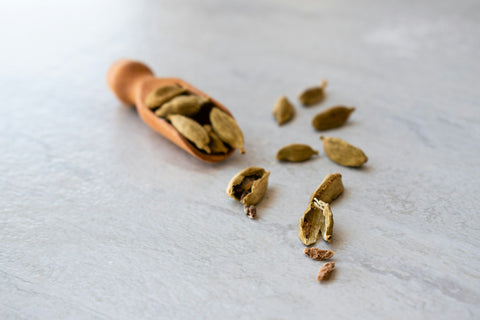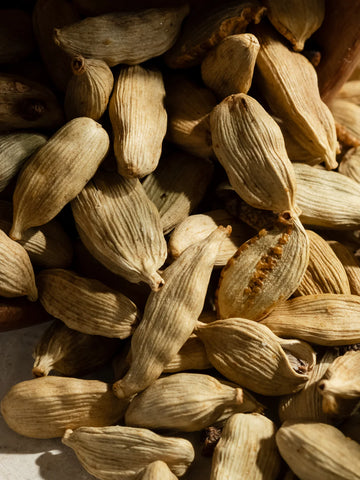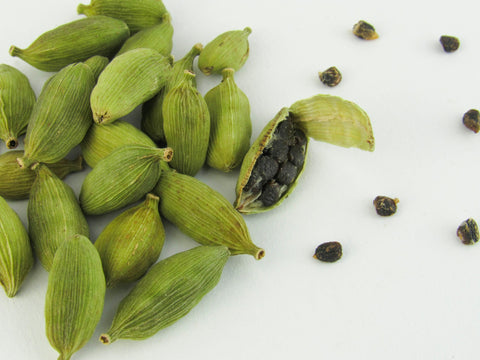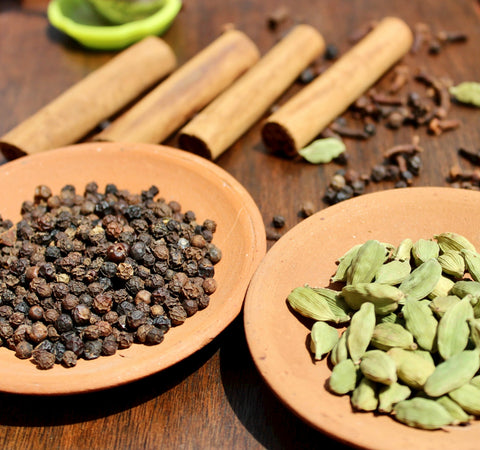Makes Perfect Scents
What is Cardamom and Why is it the "Queen of Spices"?
Feb 27, 2024
Cardamom, often heralded as the "Queen of Spices," is celebrated for its intoxicating aroma and distinct flavor. Despite its prominence in various cuisines and cultures, many remain unaware of its rich heritage, health benefits, and the unique essence that sets it apart. This spice is not just a culinary delight but a sensory experience, weaving history, health, and flavor into every use.

In this post, you'll learn:
- The origins and types of cardamom.
- The unique fragrance profile of cardamom.
- Health benefits associated with cardamom.
Dive into the aromatic world of cardamom and uncover the secrets that make this spice a treasure in kitchens and cultures around the globe.
What is Cardamom?
Cardamom is more than just a spice; it's a journey through time and geography. Originating from the wild forests of the Western Ghats in Southern India, cardamom has found its way across the world, becoming a cornerstone in various culinary traditions. It belongs to the ginger family, Zingiberaceae, and is prized for its pods, which contain seeds that are ground into the spice we use.

There are primarily two types of cardamom: Green and Black. Green cardamom, known for its sweet and eucalyptus-like flavor, is commonly used in both sweet and savory dishes, ranging from Scandinavian pastries to South Asian curries. Black cardamom, with a smokier and more robust profile, is favored in hearty meat dishes and lends a complex aroma to spice blends.
The production of cardamom is not limited to India; Guatemala has emerged as the largest producer and exporter, followed by India and Sri Lanka. The spice's global journey from ancient trade routes to modern kitchens underscores its universal appeal and enduring value.
The Fragrance Profile of Cardamom
The fragrance of cardamom is as intriguing as its history, a complex bouquet that captivates the senses. Sweet, yet spicy, with hints of lemon, mint, and smoke, cardamom's aroma is unmistakable and difficult to replicate. This unique scent profile makes it a favorite in culinary applications, perfumery, and aromatherapy alike.

In the realm of spices, cardamom’s aroma stands out for its versatility. It complements a wide array of ingredients and dishes, from sweet baked goods to robust curries. Its eucalyptus-like freshness can brighten flavors, while its underlying warmth adds depth and complexity.
Beyond the kitchen, cardamom's fragrance has found a cherished place in the world of perfumery. Its essential oil, derived from the seeds, is a valued component in high-end fragrances, lending a spicy, exotic note that is both refreshing and warm. Additionally, in aromatherapy, cardamom essential oil is sought after for its invigorating and soothing properties, believed to alleviate stress and improve mental clarity.
The multifaceted aroma of cardamom underscores its title as the "Queen of Spices," offering a sensory experience that is both enriching and enigmatic. It invites exploration and experimentation, promising to unlock new dimensions of flavor and fragrance in various creations.
5 Health Benefits of Cardamom
Cardamom is not just celebrated for its aromatic qualities and culinary versatility; it also boasts a plethora of health benefits, making it a valuable addition to any diet. Its therapeutic properties have been recognized for centuries in traditional medicine, and recent studies have begun to support these age-old claims with scientific evidence.

- Digestive Health: Cardamom is renowned for its ability to aid in digestion. Its natural carminative properties help in relieving gas, bloating, and indigestion. Cardamom also stimulates the secretion of bile acid in the stomach, further aiding in digestion and fat metabolism.
- Antioxidant and Anti-inflammatory Properties: The spice is rich in compounds that have strong antioxidant and anti-inflammatory effects. These compounds help protect cells from damage and reduce inflammation in the body, potentially lowering the risk of chronic diseases such as heart disease and cancer.
- Oral Health: Chewing cardamom pods is a traditional remedy for bad breath and improving oral health. The spice's antimicrobial properties can help fight bacteria in the mouth, reducing the risk of gum diseases and infections.
- Blood Pressure Regulation: Some studies suggest that cardamom may help lower blood pressure levels, thanks to its diuretic effect and high potassium content. This can contribute to improved heart health and reduced risk of stroke and heart attack.
- Anti-cancer Properties: Emerging research indicates that certain compounds in cardamom may have anti-cancer properties, inhibiting the growth of tumors and killing cancer cells without harming normal cells.
The health benefits of cardamom extend beyond these highlights, touching on areas such as respiratory health, detoxification, and even mood regulation. Incorporating this spice into your diet can not only enhance the flavor of your meals but also contribute significantly to your overall well-being.
Culinary Uses of Cardamom
The culinary applications of cardamom are as diverse as its fragrance profile, making it a cherished spice in kitchens around the world. Its ability to enhance both sweet and savory dishes with its unique flavor and aroma has made it a staple in many traditional and modern recipes.
- In Cooking: Cardamom is a key ingredient in South Asian cuisine, especially in curries, biryanis, and masalas, where it adds a layer of complexity and depth. Its use, however, extends far beyond these dishes. In Scandinavian countries, cardamom is used to flavor bread, pastries, and desserts, such as the Finnish pulla or the Swedish kardemummabullar (cardamom rolls).
- In Beverages: Cardamom's warm and aromatic qualities make it a favorite spice for beverages. It is an essential component of masala chai, a spiced tea beverage originating from India. Additionally, it is used in coffee in the Middle East, particularly in Turkish and Arabic traditions, imparting a unique flavor and aroma to the brew. Cardamom can also be found in various alcoholic and non-alcoholic beverages, adding a touch of exotic spice to cocktails and warming drinks like the Scandinavian glögg.
- Innovative Recipes: Chefs and home cooks alike are finding new ways to incorporate cardamom into their cooking, from cardamom-infused chocolate to spiced jams and chutneys. Its versatility also extends to savory dishes, such as marinades for meats and vegetables, where it contributes a subtly sweet and spicy note.
The key to harnessing cardamom's full potential lies in its proper use. Whole pods can be used to infuse dishes with a milder flavor, while ground cardamom delivers a more intense taste. Experimenting with cardamom in various dishes can elevate the flavor profile and introduce a delightful aromatic quality to everyday meals.
How to Select, Store, and Use Cardamom
Selecting the right cardamom and storing it properly is crucial to preserving its fragrant aroma and potent flavor. Whether you're using it for its culinary prowess or health benefits, knowing how to handle cardamom can make all the difference.
Selecting High-Quality Cardamom:
-
Whole vs. Ground: Opt for whole cardamom pods over pre-ground cardamom when possible. The seeds inside the pods retain their essential oils and flavor longer than ground seeds.
-
Appearance: Look for pods that are plump, vibrant in color, and have a strong, sweet aroma. Green cardamom should be a bright green, while black cardamom will be darker and larger.
Storing Cardamom:
-
Airtight Containers: Store cardamom in an airtight container away from direct sunlight and heat, which can cause the spice to lose its flavor quickly.
-
Whole Pods: Keeping cardamom in its pod form until use will help maintain its freshness and flavor for longer. Ground cardamom should be used relatively quickly, as it loses its potency faster.
Using Cardamom in Cooking:
-
Grinding: For the freshest flavor, grind cardamom seeds with a mortar and pestle just before cooking. You can use either the seeds from green cardamom pods or black cardamom, depending on the recipe.
-
Infusing Flavors: Whole pods can be added to dishes as they cook to infuse them with cardamom's aroma and flavor. Remember to remove the pods before serving.
-
Experiment: Don't be afraid to experiment with cardamom in your recipes. Its versatile flavor profile makes it suitable for a wide range of dishes, from savory to sweet.
Understanding how to select, store, and utilize cardamom will elevate your culinary creations, allowing you to fully embrace the aromatic and flavor complexities of this exquisite spice.
Cardamom, the "Queen of Spices," offers a unique blend of aromatic pleasure and health benefits that have captivated cultures around the world for centuries. From its origins in the Western Ghats of India to its place in kitchens and perfumeries globally, cardamom continues to enchant and heal.
- The origins and types of cardamom remind us of the spice's rich history and its versatile applications in cooking and medicine.
- The unique fragrance profile of cardamom has established it as a favorite in culinary arts, perfumery, and aromatherapy, highlighting its multifaceted nature.
- Health benefits associated with cardamom, including digestive aid and anti-inflammatory properties, underscore the spice's role in a balanced and healthful diet.
As we've explored cardamom's vibrant world, it's clear that this spice's journey from ancient markets to modern dishes is as fascinating as its flavor. Whether you're a seasoned chef or a culinary novice, incorporating cardamom into your repertoire can transform your dishes and delight your senses.
Eager to discover more about the power of spices? Consider delving into the world of turmeric next. Known for its anti-inflammatory and antioxidant properties, turmeric is another spice that offers a wealth of flavor and health benefits, making it a perfect next step in your exploration of culinary and wellness spices.













